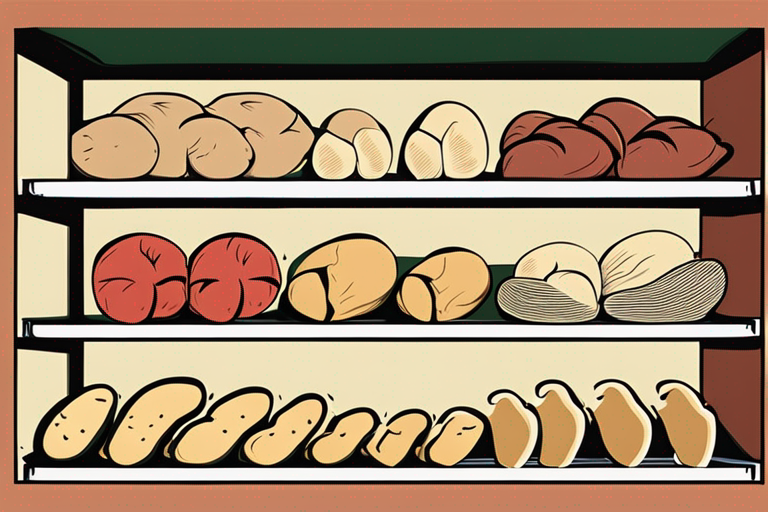
Maximizing the Shelf Life of Potatoes: A Comprehensive Guide
Get Your Free Food Safety Cheat Sheet
30 most common foods with instant answers. Print it and stick it on your fridge—completely free!
Maximizing the Shelf Life of Potatoes: A Comprehensive Guide
Potatoes are a versatile and beloved staple in many cuisines around the world. Not only are they delicious, but they are also packed with essential nutrients like vitamin C, potassium, and fiber. To ensure that your potatoes stay fresh and safe to eat for as long as possible, it's important to understand their shelf life and the best storage practices. In this guide, we will delve into the intricacies of potato storage, including tips for maximizing their shelf life and maintaining food safety. (Potatoes)
Understanding the Shelf Life of Potatoes
Potatoes, like many other fresh produce, have a limited shelf life. The exact duration varies depending on factors such as the variety of potato, storage conditions, and how they are handled. Here are some general guidelines to keep in mind:
Factors Affecting Potato Shelf Life
- Variety: Different potato varieties have varying shelf lives. Some varieties, like russet potatoes, are known for their longer storage capabilities.
- Storage Conditions: Proper storage is crucial for extending the shelf life of potatoes. Factors such as temperature, humidity, and light exposure can impact their freshness.
- Handling: Rough handling can lead to bruising and damage, which accelerates spoilage.
- Preparation: Peeled or cut potatoes have a shorter shelf life than whole, unpeeled ones.
Average Shelf Life of Potatoes
On average, properly stored potatoes can last:
- Fresh, whole potatoes: 1 to 2 months
- Peeled or cut potatoes: 1 to 2 days
- Cooked potatoes: 3 to 4 days
Best Practices for Storing Potatoes
Proper storage is key to maximizing the shelf life of potatoes and maintaining their quality. Follow these tips to ensure your potatoes stay fresh for longer:
1. Choose the Right Storage Location
- Store potatoes in a cool, dark place with good ventilation.
- Avoid storing potatoes near onions, as both vegetables release gases that can cause them to spoil faster.
- Do not refrigerate potatoes, as the cold temperature can convert the starches into sugars and affect their taste and texture.
2. Store Potatoes Properly
- Place potatoes in a paper bag, burlap sack, or a well-ventilated container.
- Check potatoes regularly for any signs of decay or sprouting, and remove any spoiled ones to prevent them from affecting the rest.
3. Handle Potatoes with Care
- Avoid washing potatoes before storing them, as dampness can promote spoilage.
- Handle potatoes gently to prevent bruising and damage.
4. Extend Shelf Life through Preparation
- If you need to peel or cut potatoes in advance, store them in a bowl of cold water in the refrigerator to prevent browning.
- Consider blanching and freezing potatoes for longer-term storage.
Safety Tips for Handling Potatoes
Ensuring food safety is paramount when handling and storing potatoes. Follow these safety tips to reduce the risk of foodborne illness:
1. Check for Spoilage
- Discard any potatoes that show signs of mold, sprouting, or rot.
- Do not consume green potatoes, as they contain high levels of solanine, a toxic compound.
2. Wash Potatoes Thoroughly
- Before cooking, wash potatoes under running water to remove dirt and any pesticide residues.
- Use a vegetable brush to scrub the skin if necessary.
3. Cook Potatoes Properly
- Cooking potatoes to the recommended internal temperature (usually around 210°F or 98°C) helps kill harmful bacteria.
- Do not leave cooked potatoes at room temperature for an extended period; refrigerate them promptly.
Conclusion
By understanding the factors that affect the shelf life of potatoes and following proper storage and handling practices, you can enjoy fresh and safe potatoes for an extended period. Remember to store potatoes in a cool, dark place, handle them with care, and always prioritize food safety. With these tips in mind, you can make the most of this versatile and nutritious vegetable in your culinary endeavors.
For more information on potatoes and other food safety tips, stay tuned to our blog for future updates! (Potatoes)
Related Posts
Here are some other articles you might find helpful:
- The Ultimate Guide to Potato Shelf Life
- Sweet Potato Shelf Life: How to Store and Extend the Freshness
- How Long Do Foods Last in the Fridge?
- Maximizing Sweet Potatoes Shelf Life: Tips for Storage and Safety
- The Ultimate Guide to Foods That Don't Need Refrigeration

Authoritative Food Safety References
These agencies and university labs inform every tip and health precaution we publish.
USDA FoodKeeper – Cold Storage Guidelines
Official refrigerator, freezer, and pantry timelines maintained by the U.S. Department of Agriculture.
Visit USDA FoodKeeperFDA Produce Safety Rule & Grower Guidance
Field-to-fridge handling practices that prevent contamination of fruits, vegetables, and leafy greens.
Visit FDA Produce SafetyCDC Foodborne Illness Prevention Hub
Surveillance-backed guidance on pathogens, symptoms, and steps to reduce foodborne illness risk.
Visit CDC Food SafetyUC Davis Postharvest Technology Center
University research detailing optimal storage atmospheres for produce after harvest.
Visit UC Davis PostharvestPenn State Extension – Home Food Preservation & Safety
Peer-reviewed extension bulletins on safe canning, chilling, and reheating practices.
Visit Penn State ExtensionHow can I extend the shelf life of potatoes at home?
Can I freeze potatoes to make them last longer?
How do I know if potatoes have gone bad?
Can I store potatoes with other fruits and vegetables?
How long can I store cooked potatoes in the refrigerator?
Get Your Free Food Safety Cheat Sheet
30 most common foods with instant answers. Print it and stick it on your fridge—completely free! Want more? Upgrade to the complete guide with 70+ foods.
Scan your food directly and get instant safety info using our AI-powered camera feature.